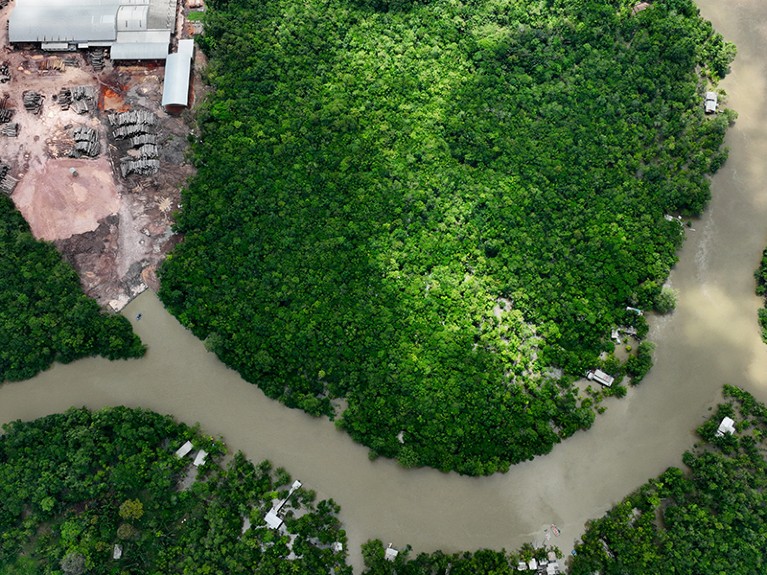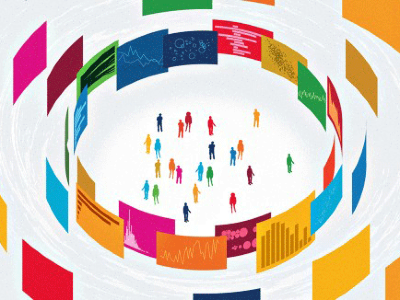
Human activities are driving the Amazon towards the limits of survival.Credit: Ueslei Marcelino/Reuters
Earth is at the start of a mass extinction event: estimates show that species are disappearing at 100–1,000 times the rate of naturally occurring extinctions1,2. It will be the sixth such event in Earth’s 4.5-billion-year history. Unlike the previous five, this one has been precipitated by the actions of one species — humans.
The 15th of the 17 Sustainable Development Goals (SDGs) agreed by the United Nations, which Nature is covering in a special series, aims to reverse this looming crisis on land. SDG 15’s aims are “to protect, restore and promote sustainable use of terrestrial ecosystems, sustainably manage forests, combat desertification, and halt and reverse land degradation and halt biodiversity loss”.
Progress towards the Sustainable Development Goals
As we have already reported in this series, progress towards a similar goal — SDG 14, to protect life below water — is going backwards. SDG 15 is also nowhere near on track. In 2019, the Intergovernmental Science-Policy Platform on Biodiversity and Ecosystem Services (IPBES) — an organization similar to the Intergovernmental Panel on Climate Change — reported3 that ecological communities on land have lost more than 20% of their original biodiversity, and that millions of terrestrial species are likely to become extinct by 2100.
The greatest driver of this loss is conversion of land on an industrial scale for human use, especially by agribusiness and industry. Every year, human activities are costing the world around 100 million hectares of natural land — and about that much forest was lost between 2000 and 2020.
There is a small silver lining: the number of countries that are tracking biodiversity as part of their official statistics has been steadily increasing, one of SDG 15’s targets. Tracking is necessary — but on its own, it is only a partial answer. A bigger issue is that the costs of environmental damage, such as biodiversity loss, rarely factor into countries’ official calculations of income and wealth. If anything, clearing a forest to build housing, grow crops or construct infrastructure to exploit fossil fuels is considered a net economic gain. An analysis of progress towards the 17 SDGs in 99 lower-income nations, published this year, confirms this: gains in reducing poverty and improving human welfare have come at a high price to the environment4. The current system is weighted towards destruction, not preservation. Now is an important moment to make a quiet revolution louder.
Margins to mainstream
For decades, researchers and policymakers have worked painstakingly to integrate environmental indicators more closely with economic ones. Their project, the System of Environmental Economic Accounting (SEEA), has become the world’s standard for measuring nature’s contribution to the economy and the impact of economic activity on the environment. It was adopted by the UN in 2012, was updated in 2021 and is now in use in 92 countries and rising. The SEEA measures stocks of environmental assets, such as a country’s forest and mineral resources, along with ‘flows’, such as the quantity of water consumed by industry.
What scientists need to do to accelerate progress on the SDGs
Most countries report these results in ‘satellite’ accounts, which measure economic sectors that are not considered industries in national accounts. Australia, for instance, publishes a national state of the environment report every five years. Canada publishes annual ecosystem accounts covering 30 variables, from road density to the numbers of people using cultural services. Uganda measures how much land is covered by grasslands, woodlands and commercial farmlands, as well as the extent of suitable habitat for important species, such as the shea tree (Vitellaria paradoxa) and the African cherry (Prunus africana).
This hard work has paid off: these data, watched and used by researchers and policymakers in conservation-related fields, are now on the radar of those in finance and economic decision-making roles.
The UN Statistics Division, based in New York City, is seeking expert comments on the next revision to the System of National Accounts (SNA). This is the international statistical standard used to measure economic activity — consumer and government spending and investments by businesses. There have been just 3 revisions in the SNA’s 70-year history. Now, questions about how the SNA can account for environmental sustainability, along with well-being, are being considered. If the SEEA and the SNA can be linked more closely, this could lead economic policymakers to pay closer attention to biodiversity loss, climate impacts and other costs. This revision is the chance for researchers and others who care about these issues to have their say (see go.nature.com/3tiucxt). The deadline is 9 October.
Make no mistake, the costs of failing to account for the environment are high, and they are here now — but they are hidden from our daily lives and concerns. A systematic approach to addressing these trade-offs is not the only answer to achieving the SDGs, but it is necessary. Properly resourcing national statistical offices to coordinate environmental accounts is also essential. Those who make economic policy decisions need to see the environmental wealth that is being whittled away as a direct result of those decisions. Only then do we stand even a remote chance of halting the sixth mass extinction event.

 Progress towards the Sustainable Development Goals
Progress towards the Sustainable Development Goals
 How much progress are we making on the world’s biggest problems? Take this quiz on plans to save humanity
How much progress are we making on the world’s biggest problems? Take this quiz on plans to save humanity
 What scientists need to do to accelerate progress on the SDGs
What scientists need to do to accelerate progress on the SDGs
 GDP at 70: why genuinely sustainable development means settling a debate at the heart of economics
GDP at 70: why genuinely sustainable development means settling a debate at the heart of economics
 Growing support for valuing ecosystems will help conserve the planet
Growing support for valuing ecosystems will help conserve the planet
 Assessing the values of nature to promote a sustainable future
Assessing the values of nature to promote a sustainable future
 Read the paper: Diverse values of nature for sustainability
Read the paper: Diverse values of nature for sustainability






